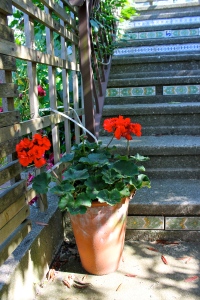Wow. I decided to start a theme on this blog, and to call it “Today’s Mission,” about things I need to do that are blog-worthy.
However, this mission took closer to a week. This is mainly because, in order to do the things I wanted to do, I had to do a bunch of other preparatory things. Or I would see other things and feel absolutely compelled to deal with them first. Also, rain.
My mission:
- plant some seeds and moss in the backyard
- empty and spread the compost
- some weeding
- call the arborist and schedule an appointment for next early spring
What I accomplished:
I got so much done! Weeding, thorough trimming of vines, cleaning tons of fallen branches (and saving for kindling), tying up droopy flowers, sweeping, cleaning up after humans, sowing seeds, transplanting in the front yard, planting the moss, dealing thoroughly with the compost, calling the arborist. Of course there’s still plenty more to do, but ain’t that always the way.
While buying seeds, we also bought some bird seed. I found our old bird feeder, filled it up, and hung it in the cherry tree. The next day… it had plumb vanished! Not that it had been knocked to the ground… it was just gone. We eventually discovered the base of it, meant to catch seeds from falling, somewhere nearby. And there was a small scattering of seeds on the ground. Otherwise, the whole thing is missing. It seems like it must have been raccoons… I don’t think squirrels could have pulled that off.
An embarrassing story: Those seeds I bought are missing. I have no idea where they are. I kept moving them, because the cats were interested in the rustling, rattling sounds the packets made when poked… and apparently I moved them one too many times. So instead, I took my box of old seeds and scattered all of them in the garden bed. All that were appropriate for that location, that is. Then I scattered all the basically non-invasive flower seeds everywhere else. Our back garden is extremely shady and the summers (coming up soon) are extremely dry, so late direct planted seedlings have a hard time–last year nothing grew in the backyard except leggy potatoes. These seeds are both old and challenged by these conditions, so I thought–the more the better! (I also went back and bought a few more seeds, mainly because we were missing kale.) Actually, another possible reason for lack of seedlings might be hungry critters. I saw squirrels digging and nibbling about an hour ago–just after being chased around the garden by some sort of hawk or falcon. However uncouth this may sound, my current pest-management plan is to have the resident male urinate around the garden bed. It works!
I tried to take “before” pictures, but it’s not a great skill of mine, since I don’t have the patience; I handed the camera to my husband and said “Just take some pictures of the areas that need attention,” which produces happenstance results.
Forking or digging doesn’t have to be difficult. This video shows an “aikido” method of both forking and digging, so that you don’t tire yourself out needlessly.
I had a hard time finding a link to the type of cultivator I used; mainly I found links to big or medium sized machines, and barring that, small hand cultivators meant to be used when you’re kneeling down in the dirt. (Useful at times, but hard on the back and knees if you’re covering much area.) Here is a picture of a non-mechanical cultivator you can use standing up. Amazon also carries a bunch of other similar cultivators. A cultivator in typical gardening is often used to loosen the soil for seeding or planting, but when possible it’s better to dig or fork the soil, so that the soil is loosened more deeply, which creates a more hospitable environment for the roots. Cultivating is best for loosening weeds, and mixing up soil that has recently been seeded, so that most of the seeds will end up a little bit under the soil’s surface. You can similarly mix in loose compost or soil amendments this way.

Before: Beginning to clean up a spot on the concrete entrance to the back yard, where leaves from trees and vines tend to drop.
This is not actually the ideal time of year to plant moss in the Pacific Northwest, since we have an annual summer drought–much like California, only shorter. However I’d been wanting moss for our shady backyard, and when I saw the moss packets being sold at the seed store, I enthusiastically picked one up. The best time to plant moss, here, would be early or mid fall, when the rains start. I’ll return to the seed store and buy more then. There’s more moss in the package that you see in the above photo, but I planted the various clumps here and there in the garden. The moss originally comes from Moss Acres. I believe the store sells a mini version of their ‘moss starter kit.’ If you have a shady garden, or shady area of your garden, moss is a way to turn it from scraggly to mystically beautiful.
I also transplanted a number of flowers in the front yard, which I’ll link to when I put up a post.









